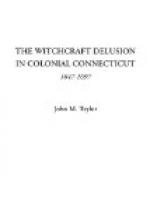his “John+Tash mark
“Grenwich July 12, 1692.
“John Tash hath given oath to his testimony abovesaid
“Before me John Renels Comessener.”
And Mistress Staplies had other qualities, always potent in small communities to invite criticism and dislike. She was a shrewd and shrewish woman, impatient of some of the Puritan social standards and of the laws of everyday life. She openly condemned certain common moralities, was reckless in criticism of her neighbors, and quarreled with Ludlow about some church matters.
It is evident from the testimonies that Staplies was on both sides as to the guilt of goodwife Knapp, and when rumor and suspicion began to point to herself as a mischief-maker and busybody in witchcraft matters, to divert attention from his wife and set a backfire to the sweep of public opinion, Thomas sued Ludlow, and despite his strong and clear defense as shown on the record evidence, the court in his absence awarded damages against him for defamation and for charging Staplies’ wife with going on “in a tract of lying,” “in reparation of his wife’s name” as the judgment reads. Mistress Staplies did not grow in grace, or in the graces of her neighbors, since some years later she was indicted for witchcraft, tried, and acquitted with others, at Fairfield, in 1692.[J]
[Footnote J: See Historical Note, p. 161.]
CHAPTER XI
“The planters of New England were Englishmen, not exempt from English prejudices in favor of English institutions, laws and usages ... They had not been taught to question the wisdom or the humanity of English criminal law. They were as unconscious of its barbarism, as were the parliaments which had enacted or the courts which dispensed it.” Blue Laws, True and False (p. 15), J. HAMMOND TRUMBULL.
“It would seem a marvellous panic, this that shook the rugged reasoners in its iron grasp, and led to such insanity as this displayed toward Alse Young, did we not know that it was but the result of a normal inhuman law confirmed by a belief in the divine, the direct legacy of England, the unquestionable utterance of Church and State.” One Blank of Windsor, ANNIE ELIOT TRUMBULL.
This brief review of witchcraft in some of its historical aspects, of its spread to the New England colonies, of its rise and suppression in the Connecticut towns, with the citations from the original records which admit no challenge of the facts, may be aptly closed by what is believed to be a complete list of the Connecticut witchcraft cases, authenticated by conclusive evidence of time, place, incident, and circumstance.
Some minor questions may be put, or kept in controversy, as one writer or another, who regards history as a matter of opinion, not of fact, and relying on tradition or hearsay evidence or on superficial investigation, gives a place to guesswork instead of truth, to historical conceits instead of historical verities.




